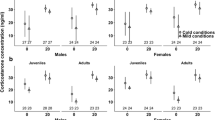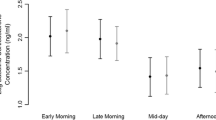Abstract
During the non-breeding season, many species of territorial migratory birds exhibit a non-random pattern of habitat distribution, with males and females occupying different habitats. In this study, we examined possible physiological consequences arising from such habitat segregation in one migrant passerine species, the American redstart (Setophaga ruticilla), on its non-breeding grounds in Jamaica, West Indies. For 2 years, we measured concentrations of corticosterone, at the time of capture (baseline) and 30 min after capture (profile of acute corticosterone secretion), in redstarts in two distinct habitats, one occupied predominately by males and one mostly by females. All redstarts in both habitat types exhibited similar concentrations of baseline corticosterone levels in fall (October), whereas in spring (March–April), redstarts in female-biased habitat exhibited significantly higher baseline levels regardless of age or sex. In fall, all individuals in both habitats exhibited significant increases in corticosterone concentration with capture and handling, but in spring only redstarts (both sexes) in male-biased habitat continued to exhibit acute corticosterone secretion. Redstarts in female-biased habitat had elevated baseline corticosterone levels and reduced acute corticosterone secretion. In spring, baseline corticosterone concentration was negatively correlated with body mass, suggesting muscle catabolism associated with high corticosterone concentrations or possibly that birds are leaner as a result of increased foraging effort. These results indicate that redstarts (primarily females) in female-biased habitats suffered a decline in physiological condition, which could in turn influence their departure schedules, migration patterns and even their condition and arrival schedules on the breeding grounds. Thus, segregation of populations into habitats of different quality during the non-breeding period may have ramifications throughout the annual cycle of such migratory species. Furthermore, these results show the usefulness of plasma corticosterone levels as indicators of physiological condition and thus habitat quality for birds during the non-breeding period.
Similar content being viewed by others
Author information
Authors and Affiliations
Additional information
Received: 14 November 1997 / Accepted: 9 March 1998
Rights and permissions
About this article
Cite this article
Marra, P., Holberton, R. Corticosterone levels as indicators of habitat quality: effects of habitat segregation in a migratory bird during the non-breeding season. Oecologia 116, 284–292 (1998). https://doi.org/10.1007/s004420050590
Issue Date:
DOI: https://doi.org/10.1007/s004420050590




